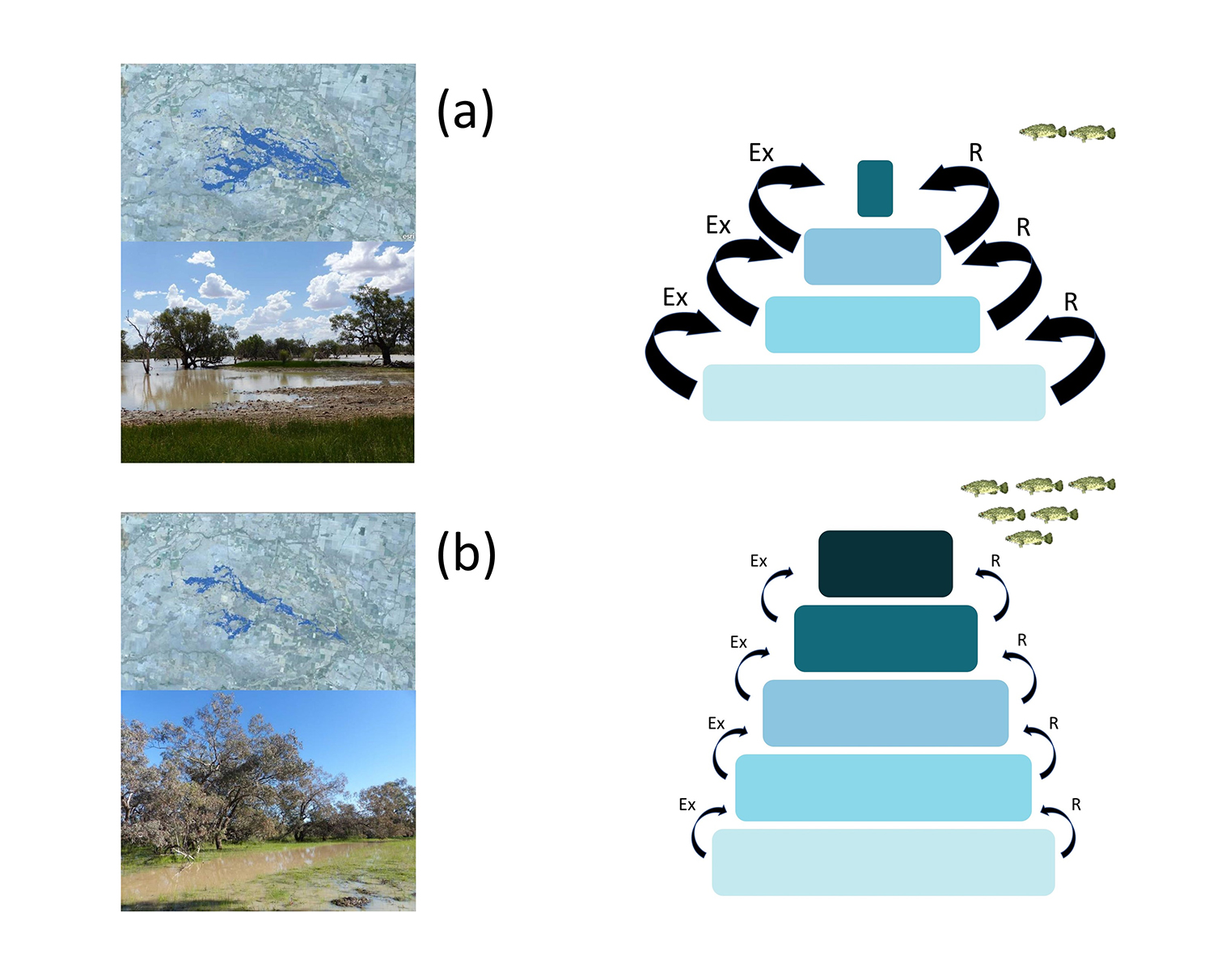Author: Julia Mynott
Floodplain wetlands comprise some of the most productive landscapes within freshwater ecosystems. They represent a transitional zone between aquatic and terrestrial communities that can support high species diversity, particularly for plants. This makes floodplain areas important for agriculture, fisheries, and biodiversity.
One of the reasons that floodplains are so productive is because of the high-quality food that they can produce for animals. For EWKR researchers a key goal was to understand how environmental flows can be used to maximise food quality in the freshwater ecosystem and benefit key groups of organisms such as fish and waterbirds.

Credit: Centre for Freshwater Ecosystems
The value of nutrition
Nutrition may be defined as the interaction of nutrients and other substances in food in relation to the maintenance, growth, reproduction and health of organisms. The value of a food source to a consumer depends on what nutrients and compounds the food source contains. Some foods are nutrient-dense relative to their calorie content, while others can be high in calories but nutrient-poor. Animals can compensate for poor quality food by eating more, but this comes at an energetic cost to the consumer as they must spend more time getting food. Some nutrients are essential for good health (e.g. essential omega 3) and must be obtained from food. Many of these compounds enter the food chain at the very bottom, from sources termed ‘basal resources’. In aquatic food webs basal resources include poor quality foods such as detritus (e.g. particulate plant matter) and high-quality foods such as green algae. The EWKR project is interested in how hydrology can be used to supply higher ratios of good quality food to support longer food chains.

Credit: Centre for Freshwater Ecosystems
Why the interest in food webs?
Thinking about food webs is useful for conceptualising relationships between ecological groups of interest and representing patterns of energy flow through ecosystems. A food web does not necessarily mean describing every trophic link between every species. It also doesn’t mean that other non-feeding interactions (e.g. competition, habitat) aren’t important. However, improving our understanding of transfer efficiency and how resources are incorporated into food webs will increase our capacity to predict the outcomes of environmental flows.
EWKR researchers undertook mesocosm experiments to investigate how variations in key basal resources influenced survival and growth of invertebrate and fish consumers. They found (shown in the diagram below) that nutritionally poor basal resources, such as detritus, supported fewer consumers even when supplied in large quantities. In contrast, basal resources rich in high quality compounds like green algae supported higher densities of consumers.

Credit: Centre for Freshwater Ecosystems
What does this mean?
Combining all this information enables us to understand that environmental water could be used to inundate floodplains and wetlands to produce high quality basal resources. Higher quality food may ultimately support increased densities of consumers, like invertebrates, fish and waterbirds. However, not all floodplain inundations are the same.
The figure below outlines two examples showing how the information generated from the EWKR food web theme can be used to inform management decisions. Under scenario (a) a large area is inundated with environmental water, this area is known to support poor quality basal resources and results in a relatively low fish biomass in this area. Under scenario (b), less water is used to target the inundation of an area known to support higher densities of high-quality green algae in seston. Under scenario (a) poor quality food results in an inefficient food web (top blue pyramid) with large gaps, where energy is lost through increased respiration (R) and excretion (Ex). While the quantity of food is the same in each example (width of pyramid base), the food web in scenario (b) supports more fish biomass (pyramid height) because food quality is better, and the food web is more efficient, supporting an extra trophic level (depicted by different colours in the pyramid) than scenario (a).

Credit: Centre for Freshwater Ecosystems.
Water management applications
Flooding has long been known to be important for the ecology of lowland rivers (e.g. the flood pulse concept), but research conducted under EWKR has extended some of these principles. EWKR has improved our understanding of fine scale mechanisms that drive trophic interactions within food webs. Promoting conditions conducive to the synthesis of high quality essential nutrients and using environmental water to improve consumer access to the floodplain could help increase the number of fish that can be supported by our rivers. This has been shown in our EWKR story: Fine dining for fish? Wetland and anabranch systems offer the ‘best fish buffets’.
The work undertaken by the EWKR food webs theme have some very interesting water management applications showing that hydrology can regulate basal resource type and the quality of the resource, and that food quality is transferred through the food web. Environmental water can be used to regulate wetland energy flow that will determine food web responses and the carrying capacity for wetland consumer recruitment. With implications for waterbird species as shown EWKR story: What’s for dinner? Understanding waterbird chick energy requirements. One of the most important outcomes is that targeted environmental flows to the correct areas can achieve more nutrition with less water and support a larger biomass of higher consumers, like fish or waterbirds.
For further information:
- contact Food Webs Theme Co-ordinator, Paul McInerney: p.mcinerney@latrobe.edu.au
- contact Centre for Freshwater Ecosystems: cfe@latrobe.edu.au
Related links:
